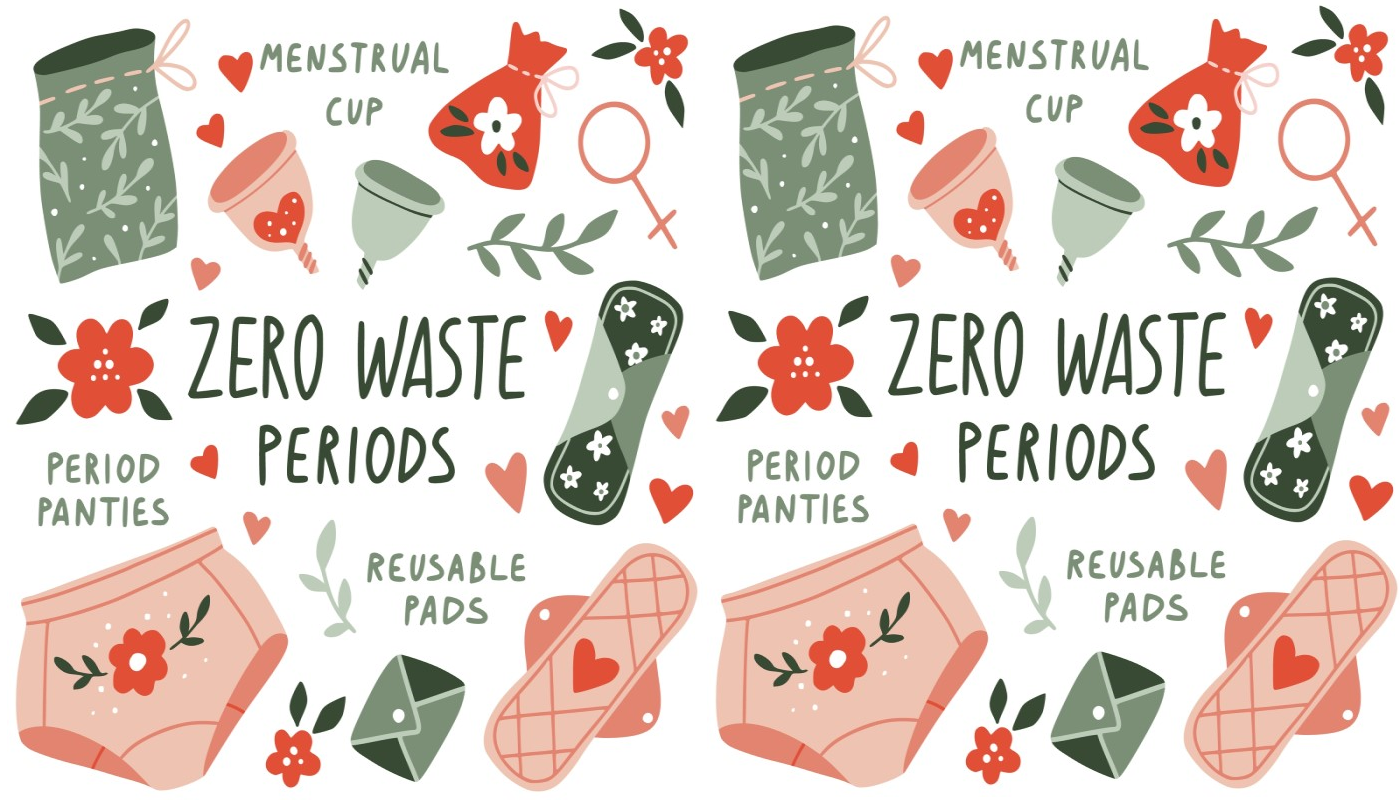According to a recent study, there are 336 million menstruating girls, women, transgender and non-binary individuals in India amounting to more than 30% of our country’s population, yet more than 23 million menstruators drop out of school every year at the start of their periods. Periods are normal and healthy, yet many menstruators across rural and urban India struggle to manage this monthly occurrence. When a menstruator faces obstacles in managing their menses in a healthy way, they are at a risk for infection, their self-esteem and self-confidence suffer, they may remain absent from school during their periods, or worse still, drop out of school altogether upon reaching puberty. Over time, these negative effects add up, preventing young menstruators from achieving their full potential and having a healthy, productive life.
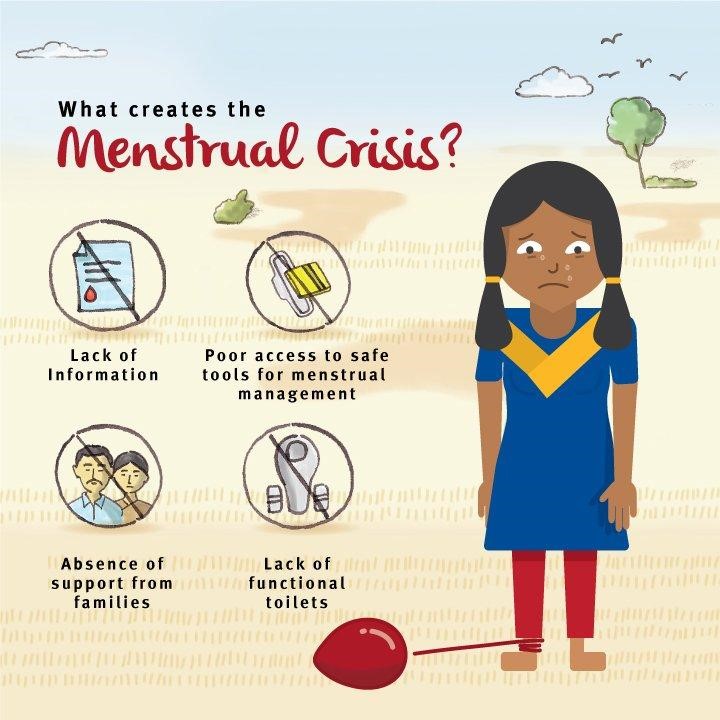
ACCESS TO MENSTRUAL PRODUCTS
Over the last few years, there has been a rising investment and engagement from donors, government, private parties, communities and individuals to address menstrual health issues. In India specifically, we have seen the following trend depicting that the use of menstrual hygiene products, specifically disposable sanitary pads, has increased significantly over the past 10 years:

RISE IN USE OF DISPOSABLE PADS ≠ BETTER MENSTRUAL HEALTH
Of 336 million menstruators in India, it can be estimated that approximately 121 million menstruators are currently using locally or commercially produced disposable sanitary napkins, and yet period is still a TABOO in our country.

FOCUS SHOULD BE ON MENSTRUAL HEALTH AND HYGIENE MANAGEMENT
Menstrual Health and Hygiene Management implies that (i) menstruators have awareness about the menstrual cycle, menstruation and menstrual hygiene management, (ii) use a clean and hygienic menstrual management material to absorb and collect blood, (iii) that can be changed in privacy, as often as necessary for the duration of the period, (iv) using soap and water for washing the body as required, (v) having access to facilities (e.g., dustbin, newspaper to wrap, safe incinerator) to dispose of used menstrual management materials.

INFORMED CHOICE
Menstrual hygiene interventions should build awareness on sustainable menstrual hygiene practices. This will have implications for the health of users, safety and dignity of sanitation workers and the environment. Such practices shall aid menstruators
in making an informed decision about choosing a menstrual product.
An informed menstrual choice is an approach that emphasizes the
right to choose a menstrual product drawing upon comprehensive and unbiased information on the product range, including their relative benefits and disadvantages, so
that it meets a menstruator’s personal,
reproductive health, socioeconomic needs and realities and are environment friendly.
Informed Choice = Hygienic + Comfortable + Affordable + Environment-friendly
MAKING AN INFORMED CHOICE
To make an informed decision on choosing the menstrual product, let us look at the various products available in the Indian market today

Menstrual Hygiene Product Landscape – India
| Category | Non – compostable disposable | Compostable disposable | Reusable |
|---|---|---|---|
| Products |
Sanitary pads and panty liners with non-compostable raw materials like plastic barriers, super absorbent polymers |
Sanitary pads with compostable raw materials | Cloth pads, Hybrid pads (with non-cloth barrier and Menstrual Cups |
| Use | One time use | One time use | Multiple use |
| Environmental Impact/ Life span | 500-800 years to decompose | 3-6 months to decompose | 12-24 months for reusable pads and underwear 5-10 years for menstrual cup |
| Cost | Multiple players; low-cost versions available | Currently higher cost than non-compostable versions | One time cost maybe high; life cycle cost is usually lower than disposables |
| Availability | Largest market share and reach | Limited | Limited |
CURRENT TREND IN CHOICE
Out of the different products available, the current trend shows that disposable sanitary pads are the most popular choice of menstruators in India:
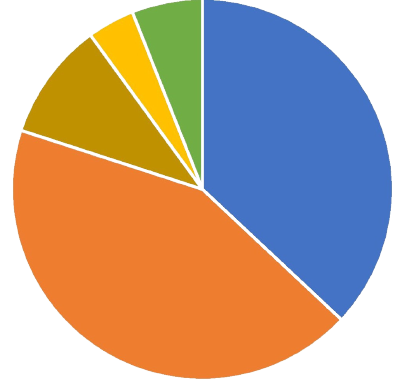
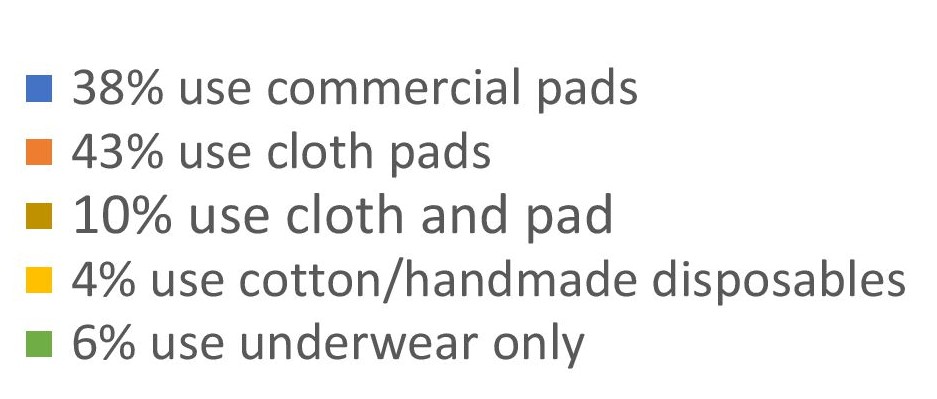
Awareness of menstrual hygiene management has typically focused on the use of just sanitary pads. A vast majority of products reaching menstruators through government and large manufacturers are
made primarily of non-compostable materials -materials that take hundreds of years to degrade.
Apart from the amount of waste generated, when menstruators do not have easy access to disposal options, they tend to wear a pad for much longer than they should, putting them at risk for unnecessary and avoidable discomfort and health issues.
We need better solutions that minimize health risks and allow us to deal with all waste effectively.
WASTE IMPACT OF MENSTRUAL PRODUCTS
The choice of menstrual products is deeply intertwined with waste management solutions, let’s look at the
waste impact of the menstrual products. There are three axes in the below graph: the Y axis on the left is the volume of the product used, the X axis at the bottom is the waste volume generated by each product,
and the third axis on the right is the environmental impact.
If we place the different types of products along these axes, this is what we see:
reusables have the lowest use volume (as they are reused),
have the lowest waste volume, and have the least environmental impact.
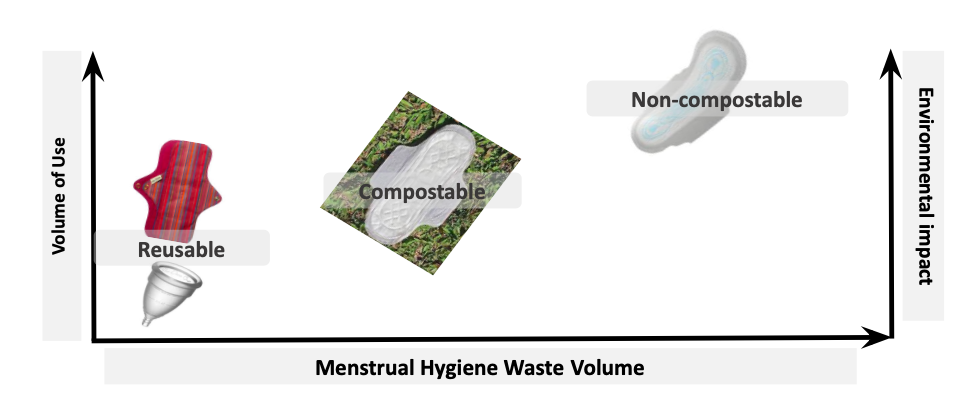
WASTE IMPACT OF DISPOSABLE SANITARY PADS
On the other hand, the load of waste created by menstruators in a year in India by using sanitary disposable pads show the below scenario:
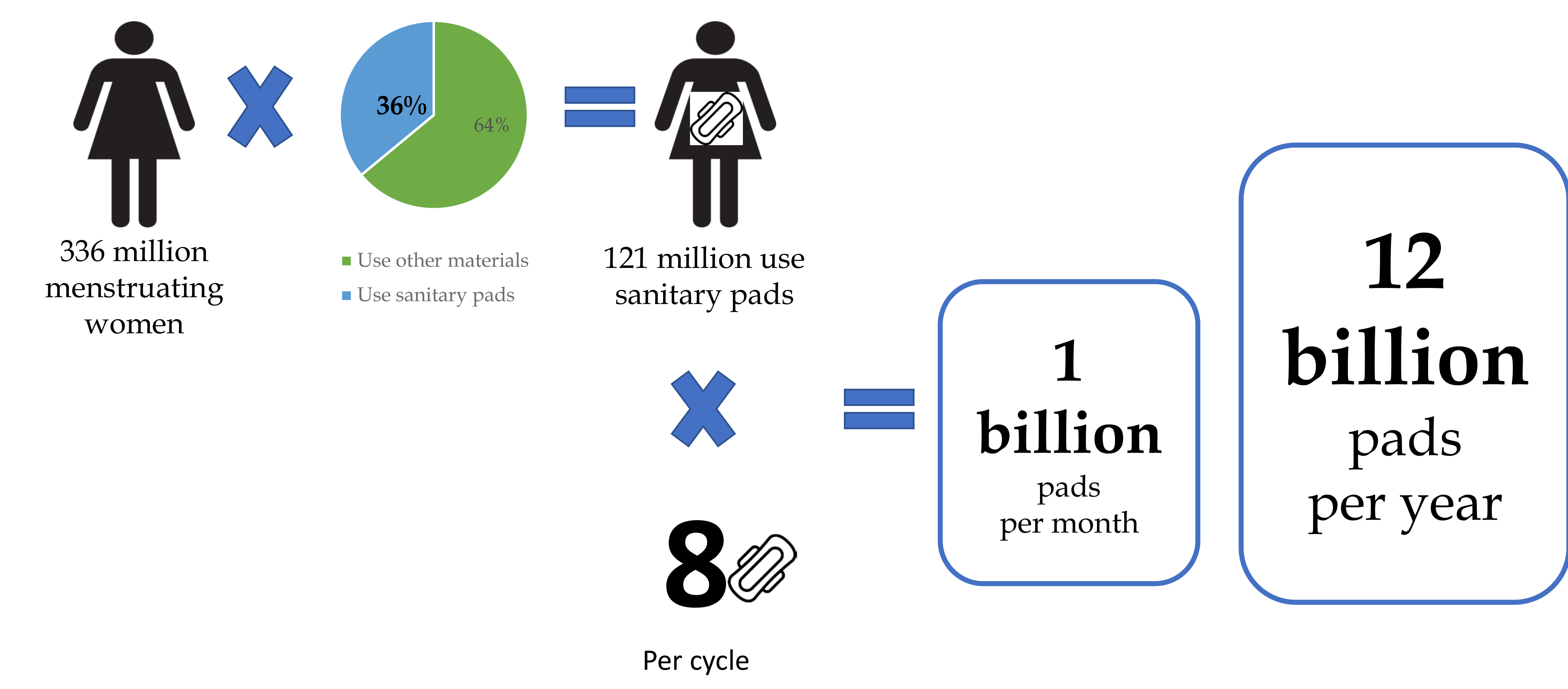
Big question is what are these 12 billion pads/year made up of and how are they disposed of after their single use?
Many sanitary pad varieties are made of cellulose, super absorbent polymers (SAP), plastic covering, and adhesives/glue. According to a recent study, single non-organic sanitary pad (commercially produced) constitutes 90% plastic equivalent to about four plastic bags and takes up to 250-800 years to decompose.
WHERE ARE 12 BILLION PADS/YEAR GOING?
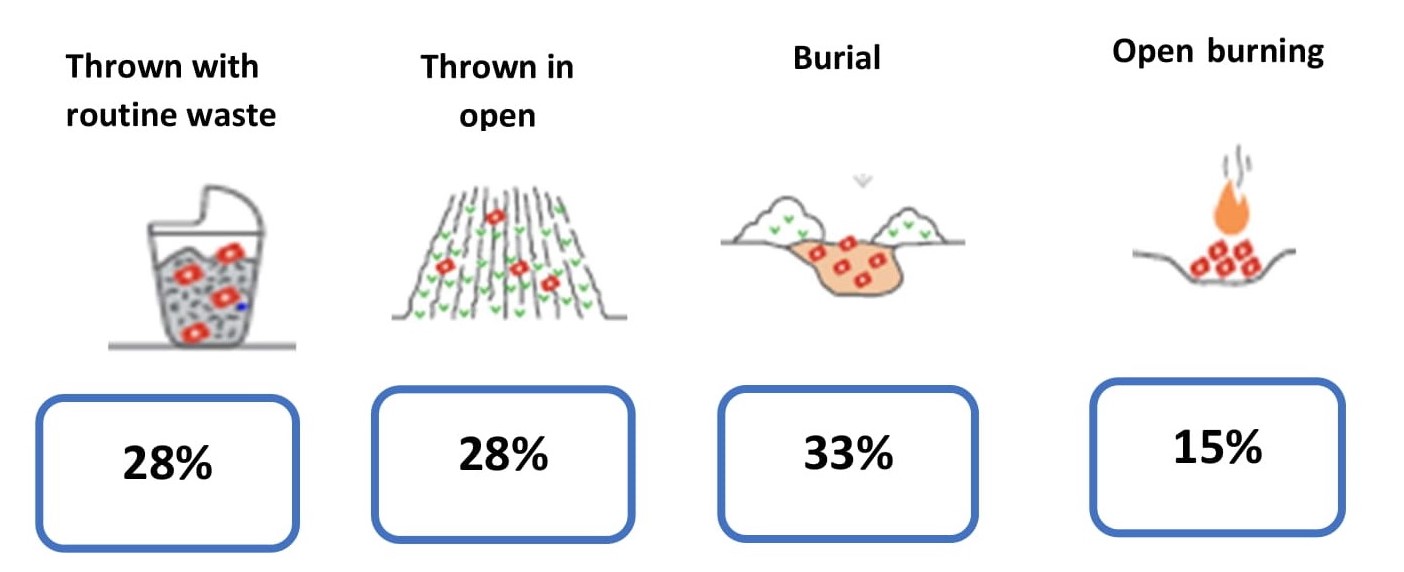
Only 28% of menstrual waste is being thrown with routine waste – but we do not know how this routine waste is dealt with. Otherwise, used sanitary napkins are being discarded by throwing them in the open, through burial, open burning – none of which are safe for the user and the environment.
MENSTRUAL WASTE OR SOLID WASTE?
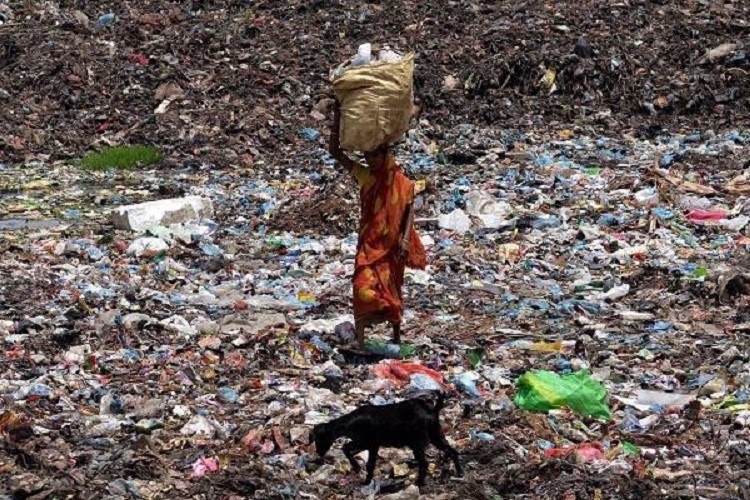
Menstrual waste is categorised as solid waste and treated at par with other disposable solid waste. It is reported that
each year around 113,000 tonnes of menstrual waste/12 billion sanitary pads add to the already polluted and mismanaged landfills in India, an already alarming issue at our hands. These pads are added to the
other waste, without any proper segregation or proper disposal technique. The key for proper disposal of sanitary waste is to
segregate such waste at source so that such waste can be treated effectively, including incineration, composting and chemical treatment. However, there is no proper management or recycling of this non -biodegradable
menstrual waste, and hence such waste ends up in landfills. Further, lack of awareness amongst menstruators of the disposal of the menstrual waste and its adverse impact on their health and environment also adds to this problem
Though the contribution of menstrual waste to the country’s annual plastic waste accumulation is less than three per cent. Tampons and organic pads can also contain plastic but in lower proportions,
and that menstrual cups are the only non-plastic alternative available to the menstruators. There more than 88% of reported menstruators who are willing to switch to environment friendly alternatives like organic
pads and menstrual cups but face difficulties in accessing and pricing of such alternatives.
